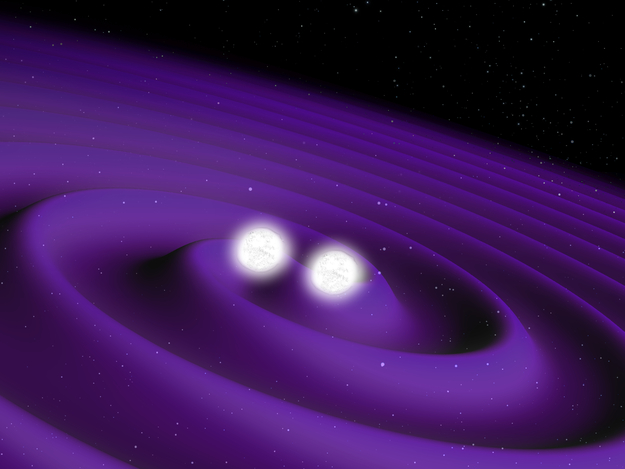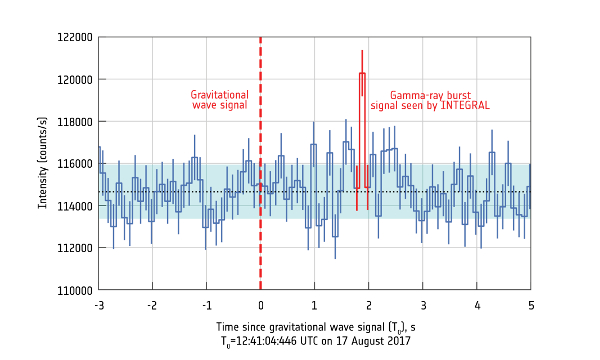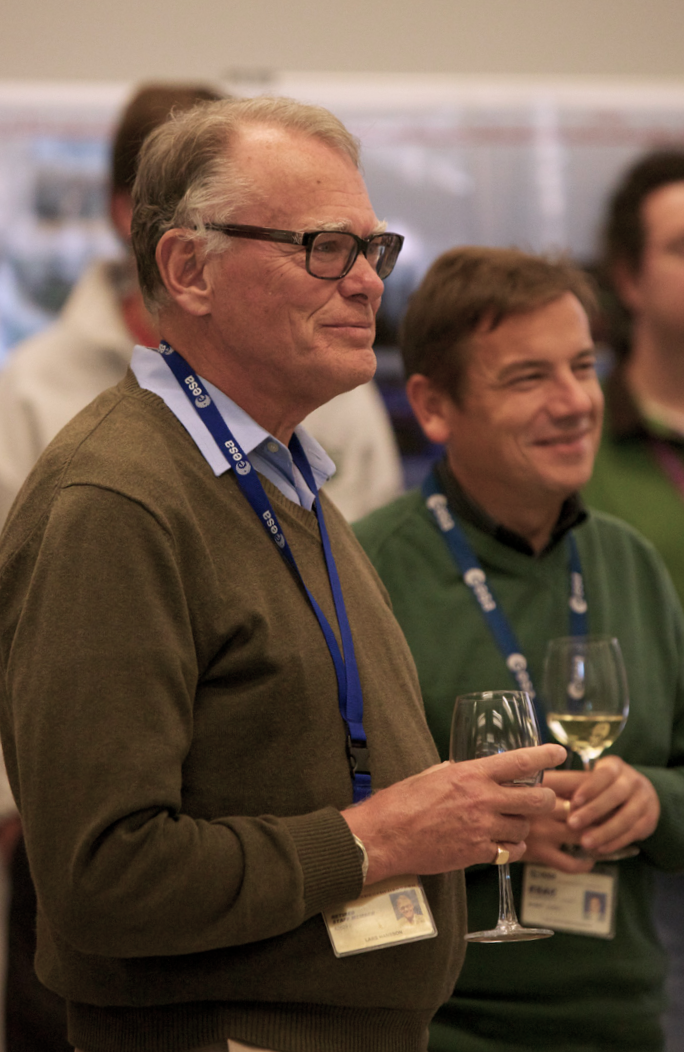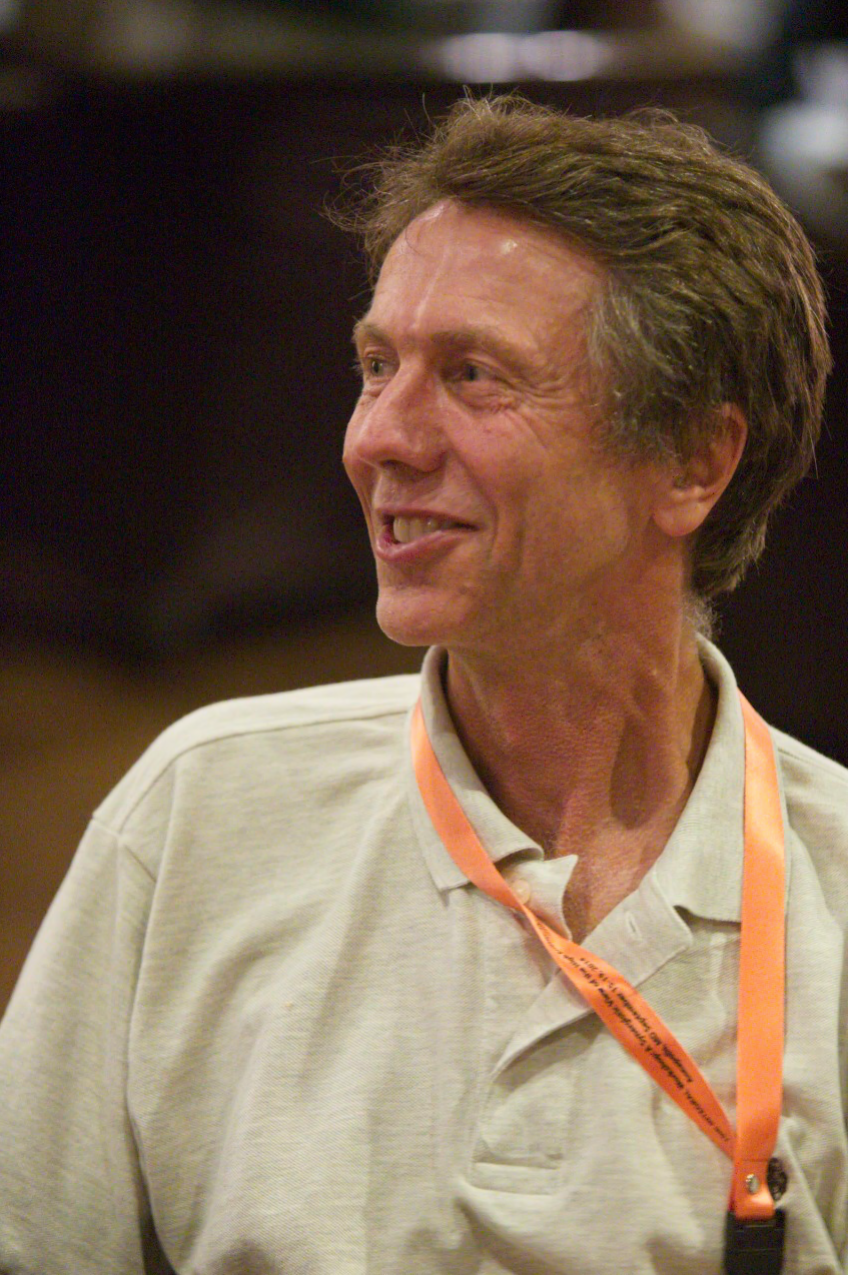News Archive 2017 - INTEGRAL
INTEGRAL News archive for 2017
Green light for continued operations
7 December 2017 ESA's Science Programme Committee (SPC) has approved indicative extensions, up to 2019-2020, for the operation of eight scientific missions, including INTEGRAL. This followed a comprehensive review of the current operational status and outlook of the missions and their expected scientific returns during the extension period. The SPC extended the operations of INTEGRAL by one year, until 31 December 2019. A proposal to extend INTEGRAL until the end of 2020 will be presented to the next meeting of the SPC in February 2018. The decision will be subject to confirmation towards the end of 2018.

Happy Birthday - INTEGRAL celebrates 15 successful years in orbit
17 October 2017 Fifteen years ago, on 17 October 2002 at 6:41 GMT, the European Space Agency's INTEGRAL observatory was launched.
From rare breeds of high-energy stars to the feeding habits of monster black holes and the annihilation of antimatter, the mission has been uncovering the secrets of the most energetic phenomena in the Universe. And since it is never too late to try something new, in recent times INTEGRAL has begun to play a crucial role in new fields of astrophysics, like follow-up of high-energy neutrinos, or especially exciting: the study of gravitational wave sources.

INTEGRAL sees blast travelling with gravitational waves

16 October 2017 
The detection, most probably the tell-tale-sign of a neutron star merger, led to an intense follow-up campaign by a large number of ground and space telescopes. First results have been made public in press conferences all around the world and scientific papers published in a special issue of the Astrophysical Journal Letters. For more detail, please read the ESA Press Release.

Target-of-Opportunity observations of MAXI J1535-571
8 September 2017 INTEGRAL started a public Target-of-Opportunity observation today, in Revolution 1860, of the recently detected candidate black-hole X-ray binary MAXI J1535-571. This source has also triggered an accepted monitoring program proposal (PI: Belloni). First observations are scheduled in Revolution 1861. Data will be also public.

Strongest flare in a decade from the Sun affects INTEGRAL
7 September 2017 The strongest Solar flare in a decade was released from the Sun yesterday, and made its impact on Earth and its surroundings. The X9.3 flare caused the OMC and JEM-X to go into safe Mode on 6 September 14:03 and 7 September 02:17 UTC, respectively.
Update 8 September 2017 JEM-X and OMC have been activated again today, around 12:21 UTC.

INTEGRAL TOO observations of 4U 1543-624
17 August 2017 The candidate ultra-compact neutron-star binary 4U 1543-624 is currently showing an unusual rise in the hard-X-ray flux. INTEGRAL ToO observations have been requested and observations are planned for Revolution 1853 (2017-08-21 16:34:47 to 2017-08-22 06:45:46). The data will be publicly available.

Coordinated observations of GX 301–2 and Her X-1
28 July 2017 INTEGRAL will perform observations coordinated with the Chinese space mission Insight-HXMT of GX 301–2 and Her X-1, respectively. The observations are scheduled in Revolutions 1846 and 1847. The INTEGRAL data from both observations is public.

Coordinated calibration observations of 3C273
26 June 2017 INTEGRAL is performing a coordinated IACHEC calibration observation on 3C273, together with Chandra, NICER, NuSTAR, Swift and XMM-Newton. The INTEGRAL data in Revolution 1832 is public.

INTEGRAL AO-15 General Programme approved
8 June 2017 The INTEGRAL AO-15 General Programme, as recommended by the Time Allocation Committee (TAC) and approved by ESA's Director of Science (Prof. Alvaro Giménez), has been released and the observers have been informed.

IBIS/VETO correctly recovered
13 April 2017 Since yesterday UT 17:58, at the start of Revolution 1804, the VETO system of IBIS is running in the correct configuration again. Users are advised to take care of any IBIS data reduction in Revolutions 1802 and 1803.

IBIS/VETO MALFUNCTION (continued)
12 April 2017 The on-board problem with the VETO system of IBIS still continues. In summary: Revolutions 1802 and 1803 up to ScW 39 have no usable IBIS data. From Revolution 1803 ScW 40 to 65, there is about 70% of IBIS data usable. Starting from ScW 66 of Revolution 1803, there are again no more usable IBIS data due to the VETO rejection.

15TH ANNOUNCEMENT OF OPPORTUNITY (AO-15): PRELIMINARY STATISTICS
11 April 2017 The deadline for the submission of proposals for AO-15 open time observations was on 31 March 2017, and all proposals are in the ISOC database. Below are some preliminary statistics on the proposals that have been received.
Total number of proposals
The total number of proposals received is 65. The total observing time requested is about 88 Msec (for all types of observation, i.e., fixed time, normal time, and ToO). Here, 10% of the requested total ToO time has been taken into account. Given that up to about 21 Msec of observing time (for new observing proposals) will be available for the AO-15 observing programme (12 months duration starting on 1 January 2018), this corresponds to an oversubscription in time by a factor of 4.2.
The non-ToO proposals are requesting data rights for 341 sources in total. 20 proposals requested coordinated time with NuSTAR, Swift and/or XMM-Newton.
Proposals per category
In the following table we give the breakdown of number of proposals as a function of the proposal category. Note that the numbers on requested observing times do include ToO proposals, but it has been assumed here, that a typical ToO proposal requests about 10% of its total observing time as entered into PGT from all the candidate sources included in a ToO proposal.
| Scientific Category | Number of proposals | Requested observing time (Ms) includes ToO times x 10% |
| Galactic Astronomy | 39 | 56 |
| Extragalactic Astronomy | 16 | 15 |
| Nucleosynthesis and diffuse continuum/line emission |
10 | 17 |
| Total | 65 | 88 |
In mid May, the Time Allocation Committee will peer review all proposals and recommend the AO-15 observing programme to ESA.

IBIS/VETO malfunction
10 April 2017 Due to an on-board problem with the VETO system of IBIS, most of the IBIS/ISGRI data obtained during Revolution 1802 and beginning of 1803 are lost.
Update 11 April Unfortunately, during the restart yesterday the wrong (i.e., default) context table was uploaded, and so the IBIS Veto system is still not in the right configuration. Although the IBIS/ISGRI data are usable, it does make the data analysis non-standard. Work is underway to restore the right configuration.

AO-15 DEADLINE DRAWING CLOSE
28 March 2017 The deadline for proposals in AO-15 is drawing close (31 March 2017, 14:00 CEST). To aid proposers writing (new) proposals, we have compiled a checklist from the documentation.

INTEGRAL TOO OBSERVATIONS of IceCube-170321A
22 March 2017 On UT 21 March 07:32:21 IceCube detected a track-like, very-high-energy neutrino event, with a high probability of being of astrophysical origin, IceCube-170321A. Follow-up observations have been initiated on ground and space-based observatories to help to identify a possible astrophysical source for the event. This triggered an accepted AO-14 Target-of-Opportunity proposal (PI: M. Santander). INTEGRAL observations will start today at UT 15:10:29 for a duration of 45 ksec. The data will be public.
Update 23 March Unfortunately, the observations at the start of Revolution 1796 were affected by a malfunction of the IBIS Veto system. This required a partial restart of the instrument. IBIS was back in science mode from UT 16:37:52 on March 22.

Lars Hansson: 11 October 1942 - 15 March 2017

20 March 2017 Lars Hansson, former INTEGRAL Science Operations Manager passed away on Wednesday 15 March 2017.
Lars' career at ESA covered a range of missions among them COS-B, EXOSAT, Hipparcos, ISO and INTEGRAL. He retired end of 2006 as INTEGRAL Science Operations manager, having seen the INTEGRAL SOC through the development and the early mission phase. He and his wife Åsa then shared their time between Spain and Sweden.
The ISOC remembers Lars as a positive, forward driving person always supportive of the people in his team, a person we will miss.

INTEGRAL AO-15 CALL FOR OBSERVING PROPOSALS IS OPEN!
20 February 2017 Today, the Director of Science (Prof. Alvaro Giménez Cañete) has released the 15th Announcement of Opportunity (AO-15) for observing proposals with INTEGRAL.
This announcement solicits proposals for observations to be carried out from January 2018 for a period of 12 months. Proposers from all over the world are welcome to participate. All proposals will be subject to an independent peer review by the INTEGRAL Time Allocation Committee (TAC). The deadline for proposal submission is Friday 31 March 2017, 14:00 CEST.
We would like to draw your attention to the following points:
- ESA provides the opportunity to propose for coordinated observations with XMM-Newton, NASA's NuSTAR telescope and/or NASA's Swift satellite with a total of 300 ks, 100 ks and 150 ks, respectively, of their available time. Note that through an agreement with ESA, the Fermi project of NASA offers the possibility to obtain observing time with INTEGRAL through a single proposal to NASA via the Fermi AO.
- Data or science rights to the targets or science in the field of view (FOV) of the instruments will be allocated to PIs of accepted proposals with the usual 1-year proprietary period. If the PI is from a country other than the Russian Federation, the rest of the field will be made public immediately. Proposals where the PI is from the Russian Federation follow a similar kind of policy, except that the rest of the field will be made public only through the consolidated data programme. The Russian Federation scientists currently working at Russian Federation scientific institutes still have exceptional access to the near-real time data of the rest of the field.
- The INTEGRAL Project has signed a Memorandum of Understanding (MoU) with the LIGO/Virgo consortium to participate to the electro-magnetic follow-up campaign of GW signals until 1 June 2017; a renewal will be discussed in due time.
- Observations with non-standard, custom patterns, such as the GPS and Galactic scans, generally reduce scheduling efficiency, and increase workload for both the ISOC and the Mission Operations Centre. The use of non-standard patterns is now strongly discouraged. Hence custom patterns will be considered only for the highest, A-grade, proposals, and their scheduling will be done on a best effort basis.
- Following a recommendation by the IUG it is possible to submit Key Programme proposals with observations spanning two AO cycles of observations.
- Finally, we would like to remind you that there is no second call for proposals requesting data rights (so-called data rights proposals). Therefore, we strongly encourage you to submit any data rights proposals as observing time proposals in this and future AOs; amalgamation has been made more flexible.
More information can be found on the AO-15 page.

Neil Gehrels: 3 October 1952 - 6 February 2017
INTEGRAL has lost a great Mission Scientist

07 February 2017 Neil Gehrels passed away yesterday morning. Neil was PI of Swift and Project Scientist for WFIRST, and had a major role in many other high energy astrophysics missions including CGRO, INTEGRAL and Fermi. He was also President of IAU Commission D.1 on Gravitational Wave Astrophysics.
His ideas, scientific advice, contributions and critical reviews through all phases of the INTEGRAL mission development, were of great value and importance.
Neil had been battling pancreatic cancer. His health declined precipitously over the past several weeks. We will miss Neil; a very kind and very dear colleague and a great high-energy astrophysicist.
See dedicated web page here.

INTEGRAL fully recovered again
23 January 2017 On 21 January 15:30Z, IBIS was enabled in the observation timeline again and INTEGRAL returned to normal operations, with SPI still being annealed.

INTEGRAL in ESAM, recovery ongoing
18 January 2017 This morning at 05:41Z INTEGRAL has entered the Emergency Sun Acquisition Mode (ESAM) for the sixth time since launch. All active instruments went to safe mode, SPI was already inactive due to the ongoing annealing. The ESAM was triggered by diverging reaction wheel speeds during a slew. While the investigation of the root cause is ongoing, recovery operations are underway. Scientific operations will probably be picked up again at the start of the next revolution (1773) on 20 January.
Update 20 January Unfortunately, on reactivation of the instruments this morning it was found that a full deactivation and reactivation of IBIS will be required, delaying science data taking accordingly.

ISOC AO-14 observations underway and preparations for AO-15
9 January 2017 ISOC wishes you a healthy and successful 2017. The AO-14 cycle of observations started on January 1st and will last 12 months, see the INTEGRAL target lists and sky maps for details as well as the Long-Term Plan.
ISOC is preparing the next call for proposals requesting INTEGRAL observing time. The AO-15 release will be already on 20 February, with a deadline on 31 March 2017. The AO-15 cycle of observations is foreseen to begin on 1 January 2018 and has the usual duration of 12 months.
| Release of AO-15: call for observing time proposals: | 20 February 2017 | |
| Deadline for submission of observing time proposals: | 31 March 2017 (14:00 CEST) | |
| Meeting of the Time Allocation Committee: | 15-17 May 2017 | |
| Start of AO-15 cycle of observations: | 1 January 2018 |

- Removed a total of (12) style text-align:center;
- Removed a total of (8) style text-align:left;
- Removed a total of (1) style border:none;
- Removed a total of (2) style float:left;
- Removed a total of (2) style float:right;
- Removed a total of (22) border attribute.
- Converted a total of (1) center to div.
See also:
- The INTEGRAL News Archive:
[1995 - 2000] [2001] [2002] [2003] [2004] [2005] [2006] [2007] [2008] [2009] [2010] [2011] [2012] [2013] [2014] [2015] [2016] [2017] [2018] [2019] [2020] [2021] [2022] [2023] [2024] - INTEGRAL Commissioning & Performance Verification (PV) phase report
- INTEGRAL launch status reports
- ESA SciTech Website: News from the launch campaign
- ESA SciTech Website: News Archive about INTEGRAL
- The INTEGRAL Science Data Centre (ISDC) Newsletters








































 Sign in
Sign in
 Science & Technology
Science & Technology